Scotiabank Arena
Scotiabank Arena, formerly Air Canada Centre, is a multi-purpose arena located on Bay Street in the South Core district of Downtown Toronto, Ontario, Canada. It is the home of the Toronto Maple Leafs of the National Hockey League (NHL), the Toronto Raptors of the National Basketball Association (NBA) and the Toronto Rock of the National Lacrosse League (NLL). In addition, the minor league Toronto Marlies of the American Hockey League (AHL) and the Raptors 905 of the NBA G League play occasional games at the arena. The arena was previously home to the Toronto Phantoms of the Arena Football League (AFL) during their brief existence.
The Hanger The ACC | |
 | |
.jpg) Exterior view of the arena in 2018 | |
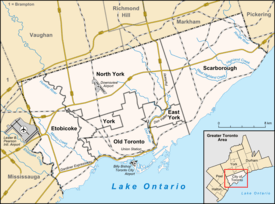 Scotiabank Arena Location in Toronto 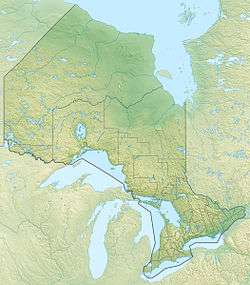 Scotiabank Arena Location in Ontario 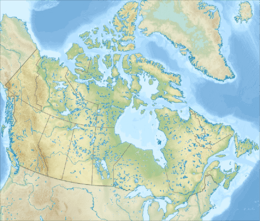 Scotiabank Arena Location in Canada | |
| Former names | Air Canada Centre (1999–2018) |
|---|---|
| Address | 40 Bay Street |
| Location | Toronto, Ontario |
| Coordinates | 43°38′36″N 79°22′45″W |
| Public transit | |
| Parking | 2 underground levels for 212 vehicles[1] |
| Owner | Maple Leaf Sports & Entertainment |
| Capacity | Basketball: 19,800 (20,511 with standing room) Hockey: 18,800 (20,270 with standing room) Lacrosse: 18,800 Concerts: 19,800 Theatre: 5,200[2] |
| Acreage | 61,780.5 m2 (665,000 sq ft)[3] |
| Construction | |
| Broke ground | March 12, 1997 |
| Opened | February 19, 1999 |
| Construction cost | CA$265 million[4][5] ($381 million in 2018 dollars[6]) |
| Architect | Brisbin Brook Beynon Architects (Architect of Record) HOK Sport (Consulting Architects)[7] |
| Project manager | Clarendon Projects Ltd.[8] |
| Structural engineer | Yolles Partnership Inc.[9] |
| Services engineer | The Mitchell Partnership, Inc.[10] |
| General contractor | PCL Constructors Western, Inc. |
| Tenants | |
| Toronto Maple Leafs (NHL) (1999–present) Toronto Raptors (NBA) (1999–present) Toronto Rock (NLL) (2001–present) Toronto Phantoms (AFL) (2001–2002) Toronto Marlies (AHL) (2010–present, occasional home games) | |
| Website | |
| scotiabankarena.com | |
The arena is 61,780.5 square metres (665,000 sq ft) in size. It is owned and operated by Maple Leaf Sports & Entertainment Ltd. (MLSE), the same group that owns the Leafs and the Raptors, as well as their respective development teams. In 2018, Scotiabank Arena was the 13th busiest arena in the world and the busiest in Canada.[11] It is also the most photographed location in Canada on Instagram according to BuzzFeed.[12] Scotiabank Arena is connected to Toronto Union railway station, subway station and bus terminal via the PATH.
Scotiabank Arena has, from its initial design to completion, revolutionized many concepts included in new arenas and stadiums built since then. These features include luxury suites accessible on the ground floor, splitting the main scoreboard into several sections, rotating all sponsor signage in the bowl at once (to allow dominant messaging or "neutralization" for events that disallow commercial advertising), and multiple restaurants in and out of the main arena bowl view.
Scotiabank Arena also hosts other events, such as concerts, political conventions and video game competitions.
History
Site history
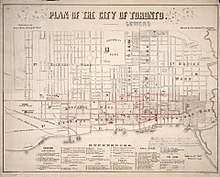
The stadium is located on land that was once part of Toronto's inner harbour. Infill of the inner harbour began in the 1850's and accelerated with the arrival of the railroad resulting in the current day shape of downtown.[13] By 1858 the site was located between two warfs (Rees & Tinnings Warf). As land was expanded southward, it remained under Government control as possible locations of various Union Station expansions. The majority of the land was still part of the lake up until the early 1900's. By 1925 The northern parcel of the property was turned into of Bayside Park, which had been part of an early proposal that was to have seen the lands south of the rail corridor transformed into an extensive lakeside park that followed today's Esplande. The remaining land was most likely under the control of Central Harbor Terminals.[14]
In the 1930s the property became the proposed home to Canada Post's Toronto Postal Delivery Building. In the 1920's a postal handling facility already existed in the east wing of the city's then New Union Station (Downtown Toronto's 3rd major train station).[15] But it quickly reached capacity by the 1930s due to major population growth of Toronto and its surrounding region.[16] In 1937 the Postmaster General appealed to the Minister of Public Works to approve a new replacement facility at the corner of Bay & Fleet Street (now Lake Shore Boulevard). Approval was granted by the federal Department of Public Works in part to stimulate the depression impacted construction industry.[17] Design and construction of the warehouse built with steel & concrete would begin in 1938. Designed by Charles B. Dolphin it's a building that incorporates a combination of Art Deco and Art Moderne architectural style. The original building would be built for around $2,000,000 (CAD)[18] [$ 35 million 2020], The building was strategically located south of Union Station and was connected directly to the train platforms via an underground tunnel. Trains would be able to directly unload mail and move it directly to the mail sorting centre.[19]
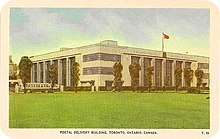
Upon completion in 1941 the building would be temporarily handed over to Department of National Defence for wartime storage purposes, and be finally turned over to Canada Post in 1946. Required modifications were made to the building to return it back to its postal delivery purposes as a result of alterations done by the Department of National Defence. After the refurbishment work was completed in 1948, the building now possessed the capability and equipment for proper mail sorting and other mailing processing functions. Though it was designed as a mail sorting warehouse it was also the home of Postal Station "A" which served mostly institutional & commercial clients. The Ground floor was where the mail was dropped off by both railway carts and postal vans. Unsorted mail was moved by conveyor belts to the top floor and via gravity fed mail chutes sorted by size & destination. Eventually the sorted mail would end up back on the ground floor where it would be sent out for delivery.[20] The building would be used as a postal sorting centre up until 1989.
Postal building sculptures
The structures most notable feature (which has been retained) are the exterior 13-part series of limestone bas relief carvings by Louis Temporale Sr. CM which depicts the history of transportation and communication in Canada.[21] Carved in 1938-39 begins with scenes showing human speech, a runner carrying a message, aboriginals communicating by smoke signal, a group of voyageurs, a schooner & a Royal Mail steamship crossing the ocean from England, the CN train used during the 1939 Royal Tour, the mythical flying boat named 'Canopus' and northern travel by dog sled.[22] The sculptors son Louis Temporale jr. helped with restoration efforts in 1998 and in 2016 was still critical of the lack of protection of the artwork by stadium ownership for over 20 years. The nearby elevated Gardiner Expressway results in salt spray which is speeding up the deterioration of the limestone.[23]
1990s Transition to Stadium
In the late 1980s, the building & antiquated sorting equipment was in need of major renovations & expensive upgrades. In a cost cutting move (part of larger overall service changes & cuts made to the Crown Corporation under the Brian Mulroney Conservatives), Canada Post decided to close the facility and move operations to an alternate more modern c.1970s letter processing faculty on nearby Eastern Avenue. A structure with easy access to highways was designed specificity for transport truck bulk delivery of mail. By 1989, all of the old building's work was transferred here.[16] The 1980s real estate boom saw the building site become surrounded by numerous skyscrapers, hotels, convention centres, SkyDome stadium & condo towers. In the early 1990s, real estate developers Bramalea Ltd and Trizec arranged to purchase the building from Canada Post, with plans to redevelop the site into a 230,000-square-metre (2,500,000 sq ft) office, retail and residential space. Financial and development details of the purchase imposed various conditions prior to development, including rezoning by the city, remediation of soil contamination by Canada Post.[24]
By this time a deep per-longed recession had taken hold in the province which saw many downtown Toronto high rise construction projects paused or cancelled outright. There was limited market demand for new office space one of the key requirements to acquiring bank loans. The resulting financing difficulties resulted in the building's ownership being reverted back to Canada Post in 1993 with the structure remaining unused & abandoned. The Toronto Raptors owners purchased the unused building from Canada Post the following year.[25]
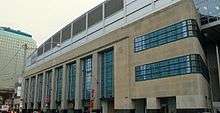
Construction of the arena was started by the Toronto Raptors, under their initial ownership group headed by Canadian businessman John Bitove. In 1995, it had been decided that the NBA would expand into Canada. The Toronto Raptors were created and would need an indoor arena to play in. The Canada Post building was chosen to be the new home of the Raptors due to its downtown location and lot size. Other venues such as Exhibition Place, North York Centre, and open lots at Bay and Wellesley, and Bay and Dundas Eaton Centre lands were also considered. The Canada Post building was purchased for CA$60 million.[16] The Raptors initially played in multipurpose SkyDome (now Rogers Centre) stadium while the arena was constructed.[26] Groundbreaking took place in March 1997. The building retained the Art Deco Queenston limestone facade of the Toronto Postal Delivery Building along the east (along Bay Street) and south (Lake Shore Boulevard) walls of that structure, but the rest of the building (facing Union Station) was demolished to make room for the arena, through the process of facadism. The original building is protected under the Ontario Heritage Act.
Arena 'Wars'
When MLGL (Maple Leaf Gardens, Limited at the time the controlling company of the Toronto Maple Leafs) lost out on their desire to be the franchise owners of the Raptors, competition between the two organizations heated up centred around venues. MLGL declined to allow Maple Leaf Gardens to be used for the NBA upstart as a result pushing Bitove to secure rights to have the Raptors' opening seasons played at SkyDome until construction of the new stadium to be complete.
The 1930s-era Maple Leaf Gardens was showing its age; the Maple Leafs in desperate desire for a new facility began developing plans for building an all-new stadium with one of the key criteria for the new location that it must be within close walking proximity to both the subway system and GO Transit. During the early stages of construction, MLGL floated to the media plans for their own plans to build a competing single-use stadium on adjacent property just to the north of the stadium atop the train sheds at Union Station (similar to how Madison Square Garden was constructed) as the new home for the Toronto Maple Leafs.[27] The reaction from Raptors was nothing but anger. "This proposed (Maple Leaf) location really disturbs us" stated team president Richard Peddie, who went on to say that they would fight the Leafs "every step of the way" and he didn't understand why the Leafs have refused to join with the Raptors at their site; claiming that the Leafs want to "build virtually on top of us".[27] The major problem of the Union Station proposal is the land that the stadium would be built on was actually City of Toronto land that was leased out to CN Rail and CP Rail, which were in a major, long-standing dispute over rent payments (dating back to 1969). As a result, MLGL offered the city $156 Million (1997 CAD) in cash & assets to settle any and all outstanding claims and to buy the air rights above the Union Station train platforms.
During this period John Bitove who disputed over the future of the arena who as a result of a shotgun clause was forced to sell his stake to Allan Slaight (who wanted a joint arena deal with MLGL) and now with majority ownership immediately went into talks with MLGL which eventually purchased both the Raptors and their partially completed arena, which subsequently resulted in major modifications to the original design, which was basketball-specific, to make the arena become more suitable for hockey. Originally planned to cost $217 million, MLGL increased the budget to $265 million after taking control.[5] The Raptors were twice fined a million dollars (which were donated to their charitable foundation) by the NBA for missing deadlines to begin construction of their new arena.[28]
Construction
After the purchase of the Raptors and the Air Canada Centre the new owners entered into a design-build contract with PCL with the commitment to finish the stadium in 24-months by March 1st 1999.[29] The intergartion of the Maple Leafs into the new structure would result in a 25% increase in construction costs (over $25 million CAD in 1999).[30]
The completed structure included a 15-storey tower (reduced from a proposed 30-stories), four restaurants, and an underground parking lot.
Opening
In 1998, a strange twist of scheduling conflicts had the Toronto Raptors playing their final regular-season game at Copps Coliseum in Hamilton, as the Toronto Blue Jays had first right of refusal for all SkyDome dates. The Raptors had attempted to play the April 19 match at Maple Leaf Gardens, but were unsuccessful.[31]
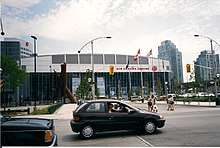
On December 30th 1998, the building's construction was completed, 9 days ahead of schedule. Opening events took place early the next year and Steve Stavro (who was the majority shareholder of MLGL) was named CEO. The initial hockey game took place February 20, 1999 (Toronto Maple Leafs vs. Montreal Canadiens), the first basketball Game on February 21, 1999 (Toronto Raptors vs. Vancouver Grizzlies), and the opening concert on February 22, 1999 (The Tragically Hip).[16] Features of the new building consist of a 65,000-square-foot (6,000 m2) arena and a 165,000-square-foot (15,300 m2) office tower. There is also an east–west covered, climate controlled galleria and walkway onsite that contains restaurants, the ticket office, and other commercial units. The Galleria also connects Scotiabank Arena to popular locations in the downtown core such as Union Station, Bay Street and York Street. Scotiabank Arena is connected to the underground PATH network. The Galleria also doubles as a historical museum by displaying numerous artifacts from the old Canada Post building.[32]
In its first ten years of operation, the new arena had an estimated economic benefit of $2.4 billion. This boosted Toronto's economy and led to further construction in the downtown core. Many projects in the area were completed ahead of schedule as a result of a desire to increase the infrastructure of downtown Toronto, and also from private funding (approximately $13 million) that was invested in seeing the economic growth of Toronto. These projects included the Bay West Teamway, Union Plaza, the Galleria (shopping centre), and Bremner Boulevard.[16]
Air Canada purchased naming rights to the arena for US$30 million for 20 years.[33] Several nicknames for the arena would emerge including 'The Hangar', but it would be the acronym 'ACC' which became the most commonly referenced shorthand for the stadium and is still commonly used by local residents.
Current history
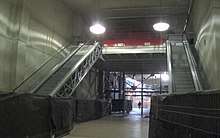
In 2003, MLSE completed a $5-million upgrade of the arena, including a new LED signage system.[34] During the summer of 2015, a $10-million upgrade of the arena was carried out, which included the installation of a new scoreboard four times larger than the previous one. The old scoreboard was later installed at Ricoh Coliseum.[35]
In the winter of 2003–2004, the Alcohol and Gaming Commission of Ontario imposed a seven-day penalty on the arena for "permitting drunken patrons to be in the licensed patrons [sic]" in the fall of 2002 at a Toronto Maple Leafs game and also a Rolling Stones concert. As a result of these misdemeanours, there was no alcohol served at the arena from December 21 to 28 in 2003. The venue had multiple major events during this time frame, which included a Toronto Raptors–Orlando Magic game on December 21, a Toronto Maple Leafs–Florida Panthers game on December 23, and Disney on Ice: Toy Story 2, which ran from December 25, 2003 to January 1, 2004.[36]
.jpg)
On September 6, 2014, a group of statues known as Legends Row was unveiled outside the arena at the southwest corner of the building.[37] The statues were situated in multiple waves from 2014 to 2016 and include Ted Kennedy, Johnny Bower, Darryl Sittler, Borje Salming, Syl Apps, George Armstrong, Mats Sundin, Dave Keon, Turk Broda, and Tim Horton. In 2017, the final four statues were unveiled including Red Kelly, Frank Mahovlich, Charlie Conacher, and Wendel Clark.[38] Legends Row now features 14 life-sized statues of former Maple Leaf players alongside a 9-metre-long (30 ft) granite players' bench.[39]
Renaming
The Air Canada Centre was renamed Scotiabank Arena on July 1, 2018. The landmark 20-year sponsorship agreement between Maple Leaf Sports & Entertainment and Scotiabank is worth about C$800 million. This is believed to be the highest-priced annual building and team sponsorship in North American sports history.[40][41] The arena is the third in Canada to bear naming rights to Scotiabank.
Maple Leaf Square
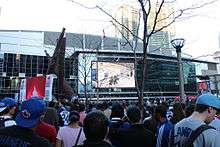
In late 2005, Maple Leaf Sports and Entertainment announced that they would be renovating the western side of the Air Canada Centre during the 2008 off-season to connect it with the Maple Leaf Square development. Maple Leaf Square is jointly owned by MLSE, Cadillac Fairview and Lantera Developments. The $500 million development includes two restaurants, Hotel Le Germain at Maple Leaf Square boutique hotel, extensive retail shopping, including a 840-square-metre (9,000 sq ft) Leafs, Marlies, Raptors, and Toronto FC store, two 54-storey condominiums, a Longo's supermarket, and a public square. It opened in 2010. The two-year, $48 million renovation of the ACC added a new atrium that includes a High-Definition broadcast studio for Leafs Nation Network (formerly Leafs TV), NBA TV Canada and GolTV Canada.
The outside wall of the atrium features a 9.1-by-15.2-metre (30 by 50 ft) video screen overlooking the plaza, which often broadcasts games taking place inside the arena. During NHL and NBA playoff runs, the square attracts thousands of Leafs and Raptors fans, respectively, sometimes broadcasting away playoff matches featuring the Leafs and/or the Raptors as well.[42] A section of the square is designated Ford Fan Zone at Maple Leaf Square, with naming rights given to the Ford Motor Company of Canada. During Raptors playoff runs, the square has acquired the nickname "Jurassic Park" after the 1993 film adaptation that inspired the team's name. During the 2019 NBA Playoffs and especially during the 2019 NBA Finals, other city squares across Canada also acquired the Jurassic Park nickname, such as in Halifax, Nova Scotia.[43]
Events
Concerts
Political conventions
In 2003, the governing Liberal Party of Canada held their leadership convention at the Air Canada Centre. Paul Martin was elected as the new leader of the party and thus also became prime minister, succeeding Jean Chrétien.
Sports
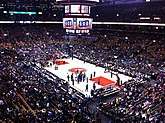

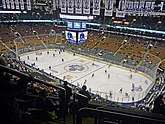
The first Maple Leafs home game took place on February 20, 1999, versus the Montreal Canadiens, won by the Leafs 3–2 on an overtime goal by Steve Thomas. Maple Leaf home games are generally sold out,[44] and there is a waitlist since the start of 2015 for Season Ticket Holders for upcoming seasons.[45] The first Raptors game took place the following night versus the then-Vancouver Grizzlies. The Raptors won 102–87 in front of a sell-out crowd. The facility hosted the 2000 NHL All-Star Game, the championship game of the 2004 World Cup of Hockey, all games of the 2016 World Cup of Hockey and the 2016 NBA All-Star Game, the first NBA All-Star Game held outside of the United States.
The Toronto Rock also moved to the Air Canada Centre from Maple Leaf Gardens for the 2001 NLL season. The Rock's first game was a 17–7 win over the Ottawa Rebel on December 21, 2000.
On October 3, 2003, Air Canada Centre had a power outage during the third quarter of a Raptors pre-season game against the Athens-based club Panathinaikos. The game was called final, because the power was not restored in time and the Raptors already had a 30-point lead.
Air Canada Centre hosted the 2015 World Junior Ice Hockey Championships for the first time, as well as hosted the final match of that tournament, in which Canada was crowned champion, defeating Russia. The ACC co-hosted that tournament with Bell Centre in Montreal, and both venues co-hosted the 2017 edition of the same event, though the ACC did not host the medal rounds.
.jpg)
In 2017, the Air Canada Centre hosted the opening and closing ceremonies for that year's Invictus Games.[46]
On September 23, 2017, the ACC presented the opening ceremony as a live two-hour event spectacular. This ceremony was designed to welcome and honour the 550 competitors and their families who come from 17 different competing nations. The show featured hundreds of cast members, including honorary men and women from the Canadian Armed Forces. The cast showed a display of ceremony in multiple different productions and the raising of the flag. Other guests of the event included celebrities, world dignitaries, headline music stars and other special guests. They gathered to celebrate the service and stories of the members of the 2017 Invictus Games. Headline performers included Laura Wright, Alessia Cara, The Tenors, Sarah McLachlan, and La Bottine Souriante.[46]
The ACC hosted the Invictus Games Toronto 2017 Closing Ceremony on September 20, 2017. The event featured an arrangement of international headline music artists, coming together to celebrate and recognize the Invictus Games competitors. The closing ceremony featured headline musical guests Bachman & Turner, Bryan Adams, Coeur de Pirate, Bruce Springsteen, and Kelly Clarkson. This celebration also included words from world dignitaries as the Games are passed to the host nation of the Invictus Games 2018, Sydney, Australia.[46]
The venue hosted its first championship series when the Raptors played the Golden State Warriors in Games 1, 2, and 5 of the 2019 NBA Finals. The Raptors won the NBA championship, albeit in the Warriors' former home arena of Oracle Arena in Oakland in Game 6.
The arena has also played host to five Ultimate Fighting Championship (UFC) events.[47][48]
| Event | Date |
|---|---|
| UFC 140 | Saturday, December 10, 2011 |
| UFC 152 | Saturday, September 22, 2012 |
| UFC 165 | Saturday, September 21, 2013 |
| UFC 206 | Saturday, December 10, 2016 |
| UFC 231 | Saturday, December 8, 2018 |
Video game competitions
On August 27 and 28, 2016, Air Canada Centre hosted the sixth season of the Summer North American Championship Series of League of Legends (LoL), marking the first professional League of Legends competition in Canada.[49] League of Legends is a popular multiplayer online battle arena (MOBA) computer game by American video game developer Riot Games; League of Legends competitions are among the most viewed among professional video game competitions worldwide. During the final round, Team SoloMid (TSM) defeated Cloud9 (C9) three matches to one in a best-of-five format. The Summer North American Championship Series serve as the qualifiers for the annual League of Legends World Championship for North American teams.
References
- https://canada.constructconnect.com/dcn/news/projects/2017/03/pcl-construction-reflects-on-building-the-air-canada-centre-1022273w
- "About". Air Canada Centre. Retrieved May 10, 2018.
- "Air Canada Centre sign removed on eve of facility becoming Scotiabank Arena". Global News. Corus Entertainment Inc. June 30, 2018. Retrieved September 27, 2018.
- "Company Facts". Air Canada Centre. Retrieved August 29, 2017.
- Shoalts, David (February 17, 1999). "Upgrades added to cost". The Globe and Mail.
- Canadian inflation numbers based on Statistics Canada tables 18-10-0005-01 (formerly CANSIM 326-0021) "Consumer Price Index, annual average, not seasonally adjusted". Statistics Canada. January 18, 2019. Retrieved March 6, 2019. and 18-10-0004-13 "Consumer Price Index by product group, monthly, percentage change, not seasonally adjusted, Canada, provinces, Whitehorse, Yellowknife and Iqaluit". Statistics Canada. Retrieved March 6, 2019.
- Faber, Michael (January 14, 2002). "Clubhouse Confidential: When a Bunch of Alpha Males Get Together Daily in a Confined Space, Lots of Things—Good and Bad—Can Happen". Sports Illustrated. Retrieved January 16, 2013.
- "Clarendon Projects – Air Canada Centre". Archived from the original on April 2, 2012.
- Halcrow Yolles – Air Canada Centre Archived October 26, 2011, at the Wayback Machine
- The Mitchell Partnership – Air Canada Centre Archived May 17, 2014, at the Wayback Machine
- "2018 YEAR END Worldwide Ticket Sales TOP 200 ARENA VENUES" (PDF). Pollstar. 2018. Retrieved June 22, 2019.
- "Scotiabank Arena now officially the home of Maple Leafs and Raptors - The Star". Toronto Star.
- https://www.cgenarchive.org/toronto-lakeshores.html
- https://maps.library.utoronto.ca/dvhmp/maps.html
- Filey, Mike (1992). A Toronto Album 2: More Glimpses of the City That Was. Toronto: Dundurn Press. p. 43.
- Arena, Scotiabank. "History | Scotiabank Arena". www.scotiabankarena.com. Retrieved November 15, 2018.
- {{Cite web|url=http://torontoplaques.com/Pages/Toronto_Postal_Delivery_Building.html%7Ctitle=History%7Clanguage=en%7Caccess-date=April 16, 2020
- Filey, Mike (1992). Toronto Sketches: The Way We Were. Toronto: Dundurn Press. p. 82.
- "History". Retrieved April 16, 2020.
- {{Cite web|url=http://torontoplaques.com/Pages/Toronto_Postal_Delivery_Building.html%7Ctitle=History%7Clanguage=en%7Caccess-date=April 16, 2020
- "History". Retrieved April 16, 2020.
- Filey, Mike (1992). Toronto Sketches: The Way We Were. Dundurn Press. p. 82.
- "History". Retrieved April 16, 2020.
- Cameron, Stevie (November 15, 1992). "Bramalea's Moves Shake Taxpayers". The Globe and Mail.
- "Laying the Groundwork for the NBA in Toronto". nba.com. Retrieved October 14, 2017.
- Bateman, Chris (February 22, 2014). "That time the Raptors and the Maple Leafs moved to the ACC". blogTo. Retrieved December 4, 2017.
- Daniels, Craig (April 16, 1997). "Leafs ready to Move (Page 2)". The Toronto Sun.
- Christe, James (May 16, 1997). "Raptors' arena bites dust". The Globe and Mail.
- https://canada.constructconnect.com/dcn/news/projects/2017/03/pcl-construction-reflects-on-building-the-air-canada-centre-1022273w
- https://canada.constructconnect.com/dcn/news/projects/2017/03/pcl-construction-reflects-on-building-the-air-canada-centre-1022273w
- "Raptors Move Final Game to Hamilton". Associated Press. January 7, 1998.
- "Air Canada Centre". PCL Constructors. Retrieved November 15, 2018.
- "Branding for dollars". CBC News. February 15, 2007.
- "Air Canada Centre Renovations to Improve Ultimate Fan Experience". Toronto Maple Leafs. September 9, 2003. Retrieved January 6, 2014.
- Mudhar, Raju (July 24, 2015). "Air Canada Centre to debut new scoreboard this year". Toronto Star. Retrieved July 24, 2015.
- "Air Canada Centre loses liquor licence for a week | CBC Sports". CBC. Retrieved November 15, 2018.
- Rubin, Josh (September 7, 2014). "Maple Leafs Legends Row starts with Ted Kennedy, Darryl Sittler, Johnny Bower". Toronto Star. Torstar Corporation. Retrieved September 27, 2018.
- "Maple Leafs Legends Row 'is full' with four added". NHL.com. Retrieved November 15, 2018.
- Hornby, Lance (October 5, 2017). "Four more Maple Leafs added to Legends Row". Toronto Sun. Postmedia Network Inc. Retrieved September 27, 2018.
- "HOME OF THE MAPLE LEAFS AND RAPTORS TO BECOME SCOTIABANK ARENA NEXT SUMMER". Maple Leaf Sports & Entertainment. August 29, 2017. Retrieved May 10, 2018.
- Westhead, Rick (August 29, 2017). "MLSE agrees to record arena rights deal with Scotiabank". TSN. Retrieved May 10, 2018.
- "Air Canada Centre Re-Opens Bigger And Better After Summer Hiatus". NBA.com/Raptors. NBA Media Ventures, LLC. September 11, 2009. Retrieved January 6, 2014.
- Lucas Powers. "Jurassic Park spin-offs popping up as Raptors fever sweeps Canada". CBC.
- Williams, Cheryl. "Toronto Maple Leafs". The Canadian Encyclopedia. Retrieved March 9, 2015.
- "Purchase Season Seats". Toronto Maple Leafs. Retrieved March 9, 2015.
- "Ceremonies". Invictus Games Toronto 2017. 2016. Retrieved August 14, 2018.
- Staff (May 14, 2013). "UFC 165 heads to Air Canada Centre in Toronto on Sept. 21". mmajunkie.com. Retrieved May 14, 2013.
- Marc Raimondi (August 19, 2016). "UFC releases schedule for rest of 2016 including UFC 206 in Toronto". mmafighting.com. Retrieved August 19, 2016.
- "LoL Esports". www.lolesports.com.
External links
| Wikimedia Commons has media related to Scotiabank Arena. |